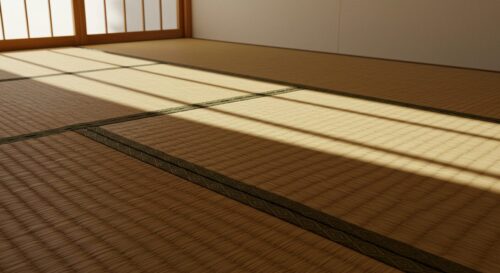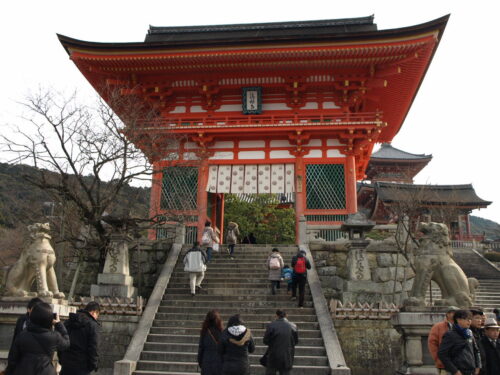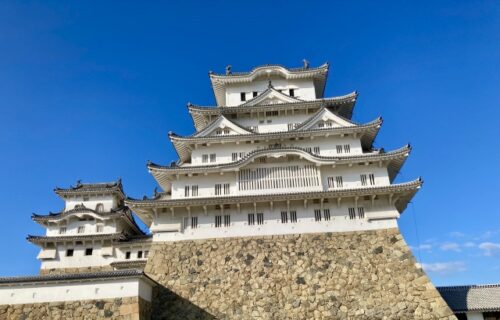Kinkaku-ji in Kyoto: Exploring Japan’s Iconic World Heritage Golden Pavilion
2025年10月15日
This guide explores Kyoto’s Kinkaku-ji, the Golden Pavilion, a UNESCO World Heritage site. Understand its history, architecture, and gardens, discovering its cultural significance and practical visit details.
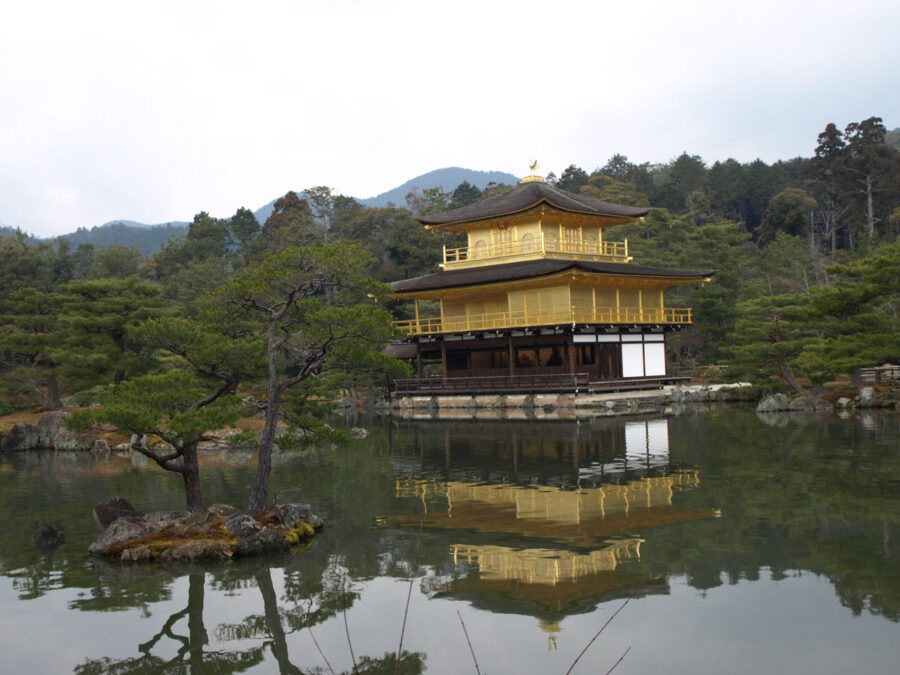
目次
- 1 Introduction to Kinkaku-ji in Kyoto
- 2 Kinkaku-ji: A UNESCO World Heritage Site
- 3 The History of Kinkaku-ji From Villa to Temple
- 4 Architectural Marvels of the Golden Pavilion
- 5 Exploring Kinkaku-ji’s Serene Gardens
- 6 Visiting Kinkaku-ji Practical Information
- 7 Beyond Kinkaku-ji: Nearby Kyoto Attractions
- 8 Conclusion
Introduction to Kinkaku-ji in Kyoto
Nestled amidst the serene landscapes of northern Kyoto, Kinkaku-ji (金閣寺) stands as one of Japan’s most iconic and visually striking landmarks. Popularly known as the “Golden Pavilion,” this magnificent structure is a testament to exquisite Japanese aesthetics and profound historical significance. Officially designated as Rokuon-ji (鹿苑寺), it functions as a Zen Buddhist temple of the Rinzai sect, captivating millions of visitors annually with its dazzling gold-leaf exterior and picturesque reflection in the tranquil Kyoko-chi Pond.
Kinkaku-ji is not merely a beautiful temple; it is a vital component of the “Historic Monuments of Ancient Kyoto,” a prestigious collection of sites inscribed as a UNESCO World Heritage Site in 1994. Its allure stems from a rich tapestry of history, dating back to the late 14th century, and an architectural brilliance that seamlessly blends different styles, making it a masterpiece of Japanese cultural heritage.
The Golden Pavilion: A Glimpse
The centerpiece of the Rokuon-ji temple complex, the Golden Pavilion (Kinkaku), is a three-story edifice renowned for its top two floors being entirely covered in brilliant gold leaf. This radiant exterior creates a breathtaking spectacle, especially when illuminated by sunlight or mirrored perfectly on the surface of the “Mirror Pond” (Kyoko-chi Pond) that it overlooks. Originally built as a retirement villa for the powerful shogun Ashikaga Yoshimitsu, it was transformed into a Zen temple after his death in 1408, fulfilling his wishes.
The temple’s stunning appearance and profound historical context make it a quintessential representation of Kyoto’s enduring legacy. Its presence evokes the opulent Kitayama culture that flourished during Yoshimitsu’s era, characterized by a fusion of courtly aristocratic and samurai aesthetics with influences from Ming-dynasty Chinese culture.
Key Facts About Kinkaku-ji
| Feature | Detail |
|---|---|
| Official Name | Rokuon-ji (鹿苑寺) |
| Popular Name | Kinkaku-ji (金閣寺), Golden Pavilion |
| Location | Kita-ku, Kyoto, Japan |
| Temple Affiliation | Rinzai Zen Buddhism, Shokoku-ji branch |
| Original Purpose | Retirement villa (Kitayamadono) for Shogun Ashikaga Yoshimitsu |
| UNESCO World Heritage Status | Part of “Historic Monuments of Ancient Kyoto” since 1994 |
| Reconstruction | Current structure rebuilt in 1955 after arson |
For more detailed information on Kinkaku-ji, you can visit the official website of Kinkaku-ji or explore its profile on Japan Guide.
Kinkaku-ji: A UNESCO World Heritage Site
Why Kinkaku-ji Holds World Heritage Status
| Aspect | Description |
|---|---|
| Official Name | Rokuon-ji (鹿苑寺) |
| Popular Name | Kinkaku-ji (金閣寺), The Temple of the Golden Pavilion |
| UNESCO Inscription Year | 1994 |
| UNESCO Designation | Part of “Historic Monuments of Ancient Kyoto (Kyoto, Uji and Otsu Cities)” |
| Key Significance | Architectural harmony, cultural influence (Kitayama culture), Zen Buddhist heritage, traditional Japanese garden design |
The Significance of Rokuon-ji Temple
The History of Kinkaku-ji From Villa to Temple
Ashikaga Yoshimitsu and the Muromachi Period
The illustrious history of Kinkaku-ji, officially known as Rokuon-ji (Deer Garden Temple), dates back to 1397. Its origins are rooted not as a temple, but as a lavish retirement villa called Kitayama-dai (北山第), originally owned by the influential statesman Saionji Kintsune during the Kamakura period (1185-1333).
The site captured the attention of Ashikaga Yoshimitsu (1358-1408), the third shogun of the Ashikaga shogunate, who acquired the villa from the Saionji family. Yoshimitsu, a pivotal figure of the Muromachi period (1336-1573), transformed the estate into his opulent retirement complex, known as Kitayama-dono (北山殿). The Muromachi period itself is named after the district in Kyoto where Yoshimitsu later relocated his government headquarters, the Hana-no-gosho (Flower Palace).
Kitayama-dono became a vibrant center for politics and the flourishing Kitayama culture, which saw a significant influx of influences from China’s Ming Dynasty through increased trade relations. Yoshimitsu’s vision for this complex was to create a “Pure Land Paradise” on earth, with the Golden Pavilion at its heart. He frequently hosted esteemed guests, including Emperor Go-Komatsu, at this magnificent estate.
Upon Yoshimitsu’s death in 1408, his will stipulated that the villa be converted into a Zen Buddhist temple. His son, Ashikaga Yoshimochi, carried out these wishes, and the complex was formally renamed Rokuon-ji, taking its name from Yoshimitsu’s posthumous Buddhist name, Rokuon-in-den. Musō Sôseki is recognized as its honorary founder.
Reconstruction and Enduring Legacy
Kinkaku-ji’s journey through history has been marked by both splendor and adversity. While the Golden Pavilion itself miraculously survived the destructive Ōnin War (1467-1477), which saw many other buildings in the complex and across Kyoto burned down, it was not immune to later catastrophes.
The most significant loss occurred on July 2, 1950, when a 22-year-old novice monk, Hayashi Yoken, set the pavilion ablaze in an act of arson, destroying the structure and an original statue of Ashikaga Yoshimitsu. This tragic event became the inspiration for Yukio Mishima’s renowned 1956 novel, “The Temple of the Golden Pavilion”.
A meticulous reconstruction effort began in 1952 and was completed in 1955, faithfully replicating the original design. The rebuilt pavilion incorporated modern fireproofing measures to ensure its longevity. Further restoration work was undertaken in 1987, when the gold leaf exterior was fully restored with a thicker application than the original, and the interior paintings and Yoshimitsu’s statue were also refurbished. The roof underwent restoration in 2003.
The enduring legacy of Kinkaku-ji is evident in its continued status as a symbol of Japanese culture and history. It was designated a UNESCO World Heritage Site in 1994 as part of the Historic Monuments of Ancient Kyoto. The temple’s resilience, from its origins as a shogun’s villa to its rebirth after destruction, embodies the Buddhist teachings of impermanence and the continuous cycle of renewal.
Key Historical Events of Kinkaku-ji
| Year | Event | Significance |
|---|---|---|
| 1397 | Ashikaga Yoshimitsu acquires Kitayama-dai and begins construction of Kitayama-dono. | Marks the establishment of Kinkaku-ji as a shogun’s retirement villa and a center of Kitayama culture. |
| 1408 | Following Yoshimitsu’s death, Kitayama-dono is converted into a Zen temple, Rokuon-ji. | Fulfills Yoshimitsu’s will, transforming the villa into a spiritual sanctuary. |
| 1467-1477 | Ōnin War | Many buildings in the complex are destroyed by fire, but the Golden Pavilion itself survives. |
| 1950 | Arson attack by a novice monk. | The Golden Pavilion is tragically burned to the ground. |
| 1955 | Reconstruction of the Golden Pavilion completed. | The current structure, a faithful replica, is unveiled. |
| 1987 | Gold leaf exterior and interior restorations completed. | Ensures the pavilion’s iconic golden appearance and preserves its artistic elements. |
| 1994 | Designated a UNESCO World Heritage Site. | Recognizes Kinkaku-ji’s outstanding universal value as part of the Historic Monuments of Ancient Kyoto. |
Architectural Marvels of the Golden Pavilion
Kinkaku-ji, officially known as Rokuon-ji, is renowned for its breathtaking architectural design, which masterfully blends three distinct Japanese styles across its three stories. This unique integration reflects the cultural amalgamation of the Muromachi period, showcasing the diverse influences on Shogun Ashikaga Yoshimitsu’s vision. The current pavilion, rebuilt in 1955, is a faithful reconstruction of the original 14th-century design.
The Three Stories and Their Styles
Each floor of the Golden Pavilion exhibits a different architectural style, creating a harmonious yet distinct visual progression from the base to the apex. This intentional design is believed to symbolize Ashikaga Yoshimitsu’s remarkable power, as he held dominion over the imperial court and the shogunate.
| Floor | Japanese Name | Architectural Style | Characteristics |
|---|---|---|---|
| First Floor | Hō-sui-in (Chamber of Dharma Waters) | Shinden-zukuri | Reminiscent of 11th-century Heian imperial aristocracy’s palace style, featuring an open space with adjacent verandas, natural unpainted wood, and white plaster walls. It houses statues of the Shaka Buddha and Ashikaga Yoshimitsu. |
| Second Floor | Chō-on-dō (Tower of Sound Waves) | Buke-zukuri | Reflects the style of samurai residences from the Kamakura period, characterized by sliding wood doors and latticed windows. This floor contains a Buddha Hall and a shrine dedicated to the Bodhisattva Kannon, surrounded by statues of the Four Heavenly Kings. Its exterior is completely covered in gold leaf. |
| Third Floor | Kukkyō-chō (Cupola of the Ultimate) | Zenshū-butsuden-zukuri (Chinese Zen Hall style) | Built in a traditional Chinese Zen style, it features distinctive bell-shaped or cusped windows. Both the interior and exterior of this uppermost floor are lavishly gilded, and it is believed to house sacred relics of the Buddha. |
The Iconic Gold Leaf and Phoenix
The most striking feature of Kinkaku-ji is undoubtedly its shimmering gold leaf. The top two stories of the pavilion are entirely covered with pure gold leaf, creating the “Golden Pavilion” for which it is famously nicknamed. The interior of the third floor is also gilded, contributing to its opulent appearance. This gold leaf, typically very thin (around 0.5 μm), serves not only as a display of wealth and beauty but also holds profound symbolic meaning. In Zen Buddhism, gold is associated with spiritual purity and the concept of impermanence, while also symbolizing a connection to the divine. It also functions as a protective layer, shielding the underlying lacquer from environmental elements and ensuring the pavilion’s longevity.
Crowning the pyramidal roof of the Golden Pavilion is a magnificent bronze ornament: a golden phoenix, known in Japanese as Hō-ō (or fenghuang in Chinese mythology). This auspicious mythical bird symbolizes divine favor, virtue, harmony, renewal, and immortality. Remarkably, this phoenix survived the devastating arson attack in 1950 because it was undergoing repairs at the time. The brilliant gold of the pavilion, especially when reflected in the tranquil Kyoko-chi Pond, creates a dazzling spectacle that blurs the lines between the earthly and the celestial, embodying the Buddhist vision of paradise.
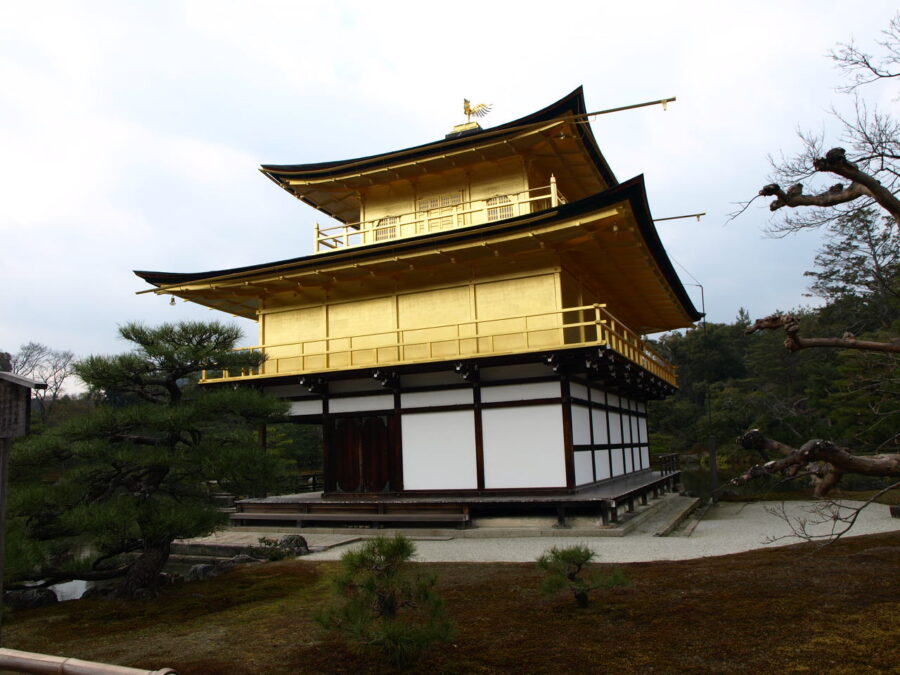
Exploring Kinkaku-ji’s Serene Gardens
Beyond the resplendent Golden Pavilion itself, the meticulously crafted gardens of Kinkaku-ji (Rokuon-ji) offer a profound experience of traditional Japanese landscape design, inviting visitors into a realm of tranquility and symbolic beauty. These gardens are a prime example of Muromachi period garden design, emphasizing the integration of structures within the natural landscape.
Kyoko-chi Pond and Reflection Views
The centerpiece of Kinkaku-ji’s garden is the expansive Kyoko-chi Pond, often translated as “Mirror Pond.” This tranquil body of water plays a crucial role in the aesthetic appeal of the temple grounds, flawlessly reflecting the shimmering Golden Pavilion and the surrounding lush greenery. The reflection, sometimes referred to as the “Inverted Golden Pavilion,” creates a breathtaking illusion of a floating palace, especially on clear days.
The pond is adorned with numerous small islands and strategically placed rocks, which are not merely decorative but hold deep symbolic meaning. These elements are arranged to represent various famous places in Chinese and Japanese literature and mythology. For instance, the largest islet in the pond is said to represent the Japanese islands, while other rock formations symbolize auspicious animals like turtles (Kame-jima, Dekame-jima, Irikame-jima) and cranes (Tsuru-jima), embodying longevity.
Visitors can appreciate the garden’s beauty by following a circuitous route around the eastern side of the pond. This “stroll garden” (kaiyu-shiki-teien or chisen-kaiyu-shiki) design encourages a leisurely walk, offering diverse viewpoints and perspectives of the pavilion and its surroundings as the scenery unfolds. The strategic placement of the pavilion itself also creates specific vantage points for viewing the gardens.
Traditional Japanese Landscape Design
The gardens of Kinkaku-ji are an exquisite example of the “paradise model” of Japanese garden design, developed during the Heian period and refined in the Muromachi period. This style aims to create a harmonious balance between heaven and earth, often drawing inspiration from Buddhist cosmology, where islands and rocks can represent mountains and seas. The design is characterized by its meticulous control over natural elements to create an idealized landscape that evokes a sense of peace and contemplation.
Key elements of Kinkaku-ji’s garden design include:
| Element | Description and Significance |
|---|---|
| Water (Kyoko-chi Pond) | Represents renewal, calm, and continuity. Its reflective surface is crucial for mirroring the pavilion, enhancing the ethereal beauty. |
| Islands and Rocks | Symbolize mountains, mythological lands (like the Isles of the Blessed), and auspicious animals (turtles and cranes), contributing to the garden’s narrative and longevity symbolism. |
| Plants and Trees | Carefully selected and pruned to imitate nature, including evergreen trees like pines (such as the 600-year-old Rikushyu-no-Matsu, shaped like a boat), Japanese cypress, and maple trees. Moss is also extensively used, symbolizing age, harmony, and tradition. |
| Borrowed Scenery (Shakkei) | The technique of incorporating distant landscapes, such as Mount Kinugasa, into the garden’s composition, creating an extended and integrated view. |
| Small Structures | Beyond the pavilion, the grounds include features like the Anmintaku Pond (said never to dry up), a small waterfall (Ryumonbaku), and the Sekkatei Teahouse, which offers a serene spot for reflection and enhances the traditional aesthetic. |
The garden’s design also embraces the concept of “wabi-sabi,” an aesthetic philosophy that finds beauty in imperfection and transience, particularly evident in the natural, evolving beauty of the landscape throughout the seasons. From the delicate cherry blossoms in spring to the vibrant autumn foliage and the magical snow-covered scenery in winter, the garden offers a unique experience with each visit, reflecting nature’s cycles and inviting contemplation.
Visiting Kinkaku-ji Practical Information
Getting to Kinkaku-ji in Kyoto
Kinkaku-ji, also known as the Golden Pavilion, is located in the Kitayama district in the northern part of Kyoto. Its address is 1 Kinkakuji-cho, Kita-ku, Kyoto-shi, Kyoto 603-8361, Japan. Reaching this iconic World Heritage Site is convenient, primarily through Kyoto’s efficient public transportation system.
From Kyoto Station
Kyoto Station serves as a major transportation hub, offering several routes to Kinkaku-ji:
- By Kyoto City Bus: This is often considered the most direct and economical method.
- Take Kyoto City Bus number 101 (from Stand B2) or 205 (from Stand B3) from the main bus terminal on the north side of Kyoto Station.
- The journey typically takes approximately 40 to 45 minutes, depending on traffic.
- Alight at the “Kinkakuji-michi” bus stop, which is just a short 3 to 5-minute walk from the temple’s entrance.
- A single ride costs 230 yen.
- Important Note: Be sure to avoid any “Rapid” bus services for route 205, as they do not stop at Kinkakuji-michi. Bus 101 often provides announcements in English, Chinese, and Korean for visitor convenience.
- By Subway and Bus: This route can sometimes be faster during peak traffic hours.
- Take the Karasuma Subway Line from Kyoto Station to Kitaoji Station. This subway ride takes about 13 to 15 minutes and costs 260 yen.
- From Kitaoji Station, exit via the south gate to the Kitaoji Bus Terminal. From the “Blue Boarding Point” (specifically E for bus 205 or G for bus 204), take Kyoto City Bus number 204 or 205 towards Kinkaku-ji.
- The bus journey from Kitaoji Station to the Kinkakuji-michi bus stop is approximately 10 to 11 minutes.
- By JR Train and Bus:
- Take the JR Sagano Line from Kyoto Station to Enmachi Station.
- From Enmachi Station, transfer to Kyoto City Bus number 204 or 205 and ride to the Kinkakuji-michi bus stop.
- By Taxi: For those prioritizing convenience and willing to spend more, a taxi offers a direct route to the temple grounds.
Opening Hours and Admission
Kinkaku-ji welcomes visitors throughout the year, offering consistent hours for planning your visit.
| Category | Details |
|---|---|
| Opening Hours | 9:00 AM to 5:00 PM daily |
| Closing Days | Open year-round; no closing days |
| Admission Fee (Adults) | 500 JPY |
| Admission Fee (Primary & Middle School Students) | 300 JPY |
| Payment Method | Cash only (Japanese Yen); credit cards are not accepted. Tickets are purchased at the entrance gate. |
Best Time to Experience Kinkaku-ji
To fully appreciate the Golden Pavilion’s splendor and minimize crowds, timing your visit strategically is key.
- Time of Day:
- Early Morning: Arriving right at 9:00 AM when the temple opens is highly recommended. The soft morning light creates stunning reflections on Kyoko-chi Pond, and fewer visitors allow for a more serene experience and better photo opportunities.
- Late Afternoon: Visiting after 4:00 PM can also offer a more peaceful atmosphere as tour groups typically depart. The setting sun casts a warm glow on the pavilion, providing a different, equally enchanting view. Aim to arrive by 4:00 PM to ensure you have enough time before closing at 5:00 PM.
- Avoid Peak Hours: The busiest times are generally between 10:00 AM and 3:00 PM, especially when large tour buses and school groups arrive.
- Best Season:
- Autumn (late October to early December): This season is arguably the most spectacular, as the vibrant reds, oranges, and yellows of the surrounding autumn foliage provide a breathtaking contrast to the golden structure.
- Winter (especially after snowfall): If you are fortunate enough to visit after a fresh snowfall, Kinkaku-ji transforms into a magical, ethereal scene, with the white snow dramatically highlighting the golden facade.
- Spring (late March to early April): Early spring offers a pleasant climate and the chance to see early blossoms, creating a beautiful backdrop for the pavilion.
- Weekdays vs. Weekends: Weekdays are generally less crowded than weekends and national holidays, offering a more tranquil visit.
For the most up-to-date information, including any special exhibition hours or changes, it is always advisable to check the official Kinkaku-ji website before your visit.
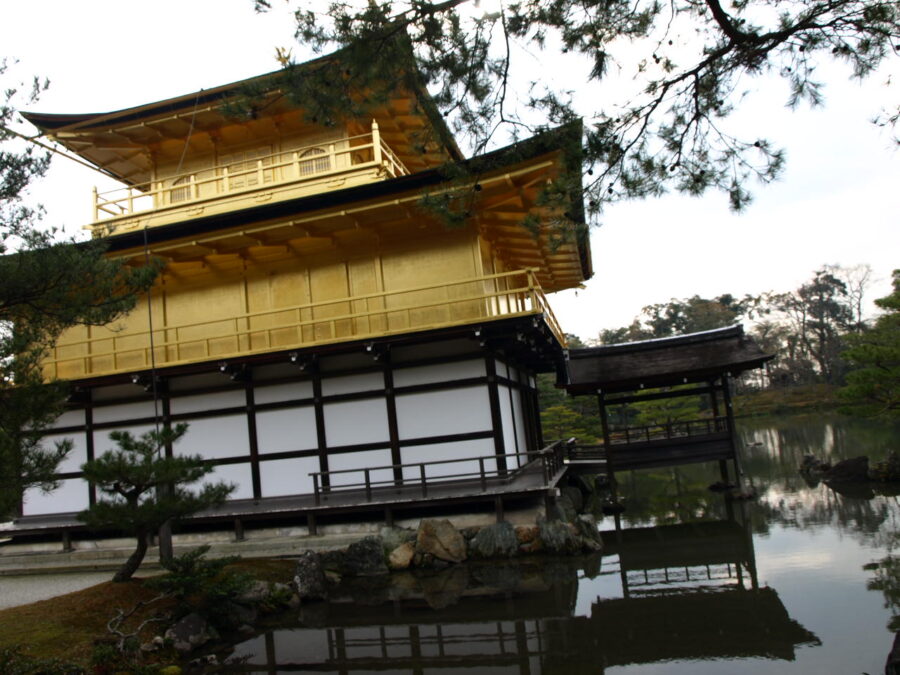
Beyond Kinkaku-ji: Nearby Kyoto Attractions
While the resplendent Golden Pavilion of Kinkaku-ji is a highlight of any Kyoto itinerary, the surrounding area in northwest Kyoto is rich with other UNESCO World Heritage Sites and cultural treasures, offering visitors a deeper immersion into Japan’s ancient capital. Many of these can be explored conveniently in conjunction with your visit to Kinkaku-ji, particularly along the scenic Kinukake-no-michi (Kinukake Road).
Ryoan-ji Temple and Its Zen Garden
Just a short distance from Kinkaku-ji, Ryoan-ji Temple stands as a profound counterpoint with its world-renowned dry landscape garden, known as “karesansui” or Zen rock garden. This iconic garden, a designated Special Historic Site and Special Place of Scenic Beauty, features fifteen carefully arranged stones of varying sizes set upon a bed of meticulously raked white gravel, with moss as the only vegetation around the stones. A unique aspect of its design is that from any vantage point on the veranda of the Hojo (abbot’s residence), at least one of the fifteen stones is always hidden from view, contributing to its enduring mystique and encouraging contemplation.
The origin and designer of this celebrated garden, believed to have been created in the late 15th century, remain a mystery, adding to its allure. Beyond the captivating rock garden, Ryoan-ji also encompasses a spacious strolling garden with the beautiful Kyoyochi Pond, which dates back to the temple’s origins as an aristocrat’s villa during the Heian Period. Ryoan-ji was converted into a Zen temple in 1450 and was designated a UNESCO World Heritage Site in 1994, recognized as one of the Historic Monuments of Ancient Kyoto.
Ninnaji Temple and Omuro Cherry Trees
Continuing your exploration in the vicinity, Ninnaji Temple, another esteemed UNESCO World Heritage Site, offers a distinct historical and natural appeal. Founded in 888 AD by Emperor Uda, Ninnaji has deep ties to the Imperial Family, traditionally having an imperial prince serve as its head priest. The temple is the head temple of the Omuro school of the Shingon sect of Buddhism.
Ninnaji is particularly famous for its “Omuro Sakura” cherry trees, which are celebrated for being Kyoto’s latest blooming cherry blossoms, typically reaching full bloom in mid-April when other varieties have already faded. These unique dwarf cherry trees grow to a shorter stature, allowing visitors to walk directly beneath their blossoms, creating an immersive “cherry blossom cloud” experience. The expansive grounds also feature significant architectural marvels, including a majestic five-story pagoda and the elegant Goten Palace, which was once the residence of the temple’s abbot and reflects the lavish residential style of an imperial palace. The Kondo Main Hall, a National Treasure, was relocated from the Kyoto Imperial Palace and showcases Heian-period palace architecture.
These three World Heritage Sites—Kinkaku-ji, Ryoan-ji, and Ninnaji—are conveniently linked by the Kinukake-no-michi, a pleasant 2.5 km walking path that allows visitors to leisurely explore these historical and natural wonders.
| Attraction | Key Feature(s) | World Heritage Status | Approx. Distance from Kinkaku-ji |
|---|---|---|---|
| Kinkaku-ji (Golden Pavilion) | Iconic gold-leafed pavilion, reflection in Kyoko-chi Pond | Historic Monuments of Ancient Kyoto (UNESCO) | — (Starting point) |
| Ryoan-ji Temple | Zen dry landscape rock garden (karesansui), Kyoyochi Pond | Historic Monuments of Ancient Kyoto (UNESCO) | 20 minutes walk |
| Ninnaji Temple | Omuro Cherry Trees, Five-story Pagoda, Goten Palace, Imperial connections | Historic Monuments of Ancient Kyoto (UNESCO) | 30 minutes walk |
Exploring these adjacent sites provides a comprehensive understanding of Kyoto’s rich history, diverse garden aesthetics, and profound spiritual heritage, making your visit to the Kinkaku-ji area a truly enriching experience.
Conclusion
Kinkaku-ji, the resplendent Golden Pavilion, stands as an undeniable symbol of Kyoto’s enduring beauty and profound historical legacy. Officially known as Rokuon-ji, this Zen Buddhist temple transcends its architectural brilliance to embody centuries of Japanese artistry, spirituality, and resilience. Its shimmering gold leaf, reflecting majestically upon the tranquil waters of Kyoko-chi Pond, offers visitors a timeless glimpse into the opulent aesthetic of the Muromachi Period, largely shaped by its founder, Ashikaga Yoshimitsu.
As a pivotal component of the UNESCO World Heritage Site “Historic Monuments of Ancient Kyoto,” Kinkaku-ji is more than just a visually stunning landmark; it is a living testament to Japan’s rich cultural tapestry. From its meticulously designed traditional Japanese gardens to the intricate details of its three distinct architectural styles, every aspect of the Golden Pavilion invites contemplation and admiration. Its story, marked by destruction and meticulous reconstruction, underscores its enduring significance and the unwavering dedication to preserving Japan’s invaluable heritage.
Key Attributes of Kinkaku-ji
| Attribute | Description |
|---|---|
| Official Name | Rokuon-ji (鹿苑寺) |
| Common Name | Kinkaku-ji (金閣寺) or Golden Pavilion |
| Historical Significance | Originally built as a retirement villa for Shogun Ashikaga Yoshimitsu in 1397 during the Muromachi Period, later converted into a Zen temple after his death in 1408. |
| Architectural Style | Features three distinct styles: Shinden-zukuri (first floor), Buke-zukuri (second floor), and Zenshū-yō or Karayo (third floor), adorned with gold leaf on the top two stories. |
| World Heritage Status | Part of the “Historic Monuments of Ancient Kyoto” UNESCO World Heritage Site, designated in 1994. |
| Gardens | Exquisite traditional Japanese landscape garden centered around Kyoko-chi Pond (Mirror Pond), designed for reflection and incorporating elements of Chinese and Japanese literature. |
A visit to Kinkaku-ji is an immersive journey into a realm where history, art, and nature converge in perfect harmony. It serves not only as a spiritual sanctuary but also as a beacon of cultural pride, drawing countless individuals from across the globe to witness its unparalleled splendor. Whether you are captivated by its historical narrative, its architectural grandeur, or the serene beauty of its surroundings, Kinkaku-ji offers an unforgettable experience, solidifying its place as an indispensable highlight of any Kyoto itinerary and a true jewel of the world’s cultural treasures.
For more information about our projects and craftsmanship, please visit our official website:
🌐 Sato Construction (Shizenya)
Watch our latest video on YouTube and see how we bring traditional Japanese architecture to life:
▶️ Sato Construction YouTube Video
